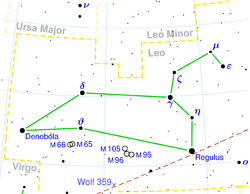沃尔夫359
| 观测资料 历元 J2000 | |
|---|---|
| 星座 | 狮子座 |
| 星官 | |
| 赤经 | 10h 56m 28.99s[1] |
| 赤纬 | +07° 00′ 52.0″[1] |
| 视星等(V) | 13.54[1] |
| 特性 | |
| 光谱分类 | M6.5 Ve[1] |
| U−B 色指数 | +1.54[1] |
| B−V 色指数 | +2.01[1] |
| 变星类型 | 鲸鱼座UV型[2] |
| 天体测定 | |
| 径向速度 (Rv) | +19±1[3] km/s |
| 自行 (μ) | 赤经:-3842[1] mas/yr 赤纬:-2725[1] mas/yr |
| 视差 (π) | 419.10 ± 2.10 mas |
| 距离 | 7.78 ± 0.04 ly (2.39 ± 0.01 pc) |
| 绝对星等 (MV) | 16.64 |
| 详细资料 | |
| 质量 | 0.09[4] M☉ |
| 半径 | 0.16[5] R☉ |
| 表面重力 (log g) | 5.5[6] |
| 亮度 | 0.0009[7] L☉ |
| 温度 | 2,800 ± 100[8] K |
| 自转 | <3.0 公里/秒[3] |
| 年龄 | 1–3.5 × 108[8] 年 |
| 其他命名 | |
| 参考数据库 | |
| SIMBAD | 资料 |
沃尔夫359(Wolf 359)是一颗小且昏暗的M型红矮星,位于狮子座内,邻近黄道,与地球的距离只有大约7.8光年。沃尔夫359非常暗淡,它的视星等是13.5等,需要大望远镜才能看见,是目前已知离太阳系第五近的恒星,只有南门二三合星系统和巴纳德星比它更靠近地球。
沃尔夫359的别名有CN Leonis、CN Leo、GJ 406、G 045-020、LTT 12923、LFT 750、LHS 36、GCTP 2553。
性质[编辑]
这颗恒星的自行在1917年首度被德国天文学家马克斯·沃夫测量出来,并在他的星表中编为359号星[9]。在1919年,他发表了超过一千颗有高自行运动的恒星星表,包括沃尔夫359,这颗恒星自此就被如此称呼了[10]。1928年,威尔逊山天文台首度测量出沃尔夫359的视差,并且提出了报告,期数值为0.409 ± 0.009″,光谱类型为dM4e。在1944年发现VB 10之前,他一直都是质量最低、光度最暗的恒星[11][12]。距离它最近的邻居是罗斯128,两者相距1.16秒差距(或是3.79光年)[13]。
这是一颗红矮星,光谱类型为M6.5[14],但是有些不同的来源会将它的光谱归类为M5.5[15]、M6[4]或M8[16]。沃尔夫359外围的大气层温度很低,可以出现FeH、CrH、H2O等分子的光谱[17],可能还有TiO和CaOH[18]。在2001年,它成为除了太阳之外,唯一由地基天文台观测到星冕光谱的恒星[19]。
这颗恒星在赤道的投影的自转速度低于3公里/秒;低于检测到的谱线致宽的数值之下[3]。如此低的自转速度被认为是磁-热恒星风造成恒星角动量流失所导致的。在时间尺度上,一颗恒星维持光谱类型为M6的时间大约是100亿年,因为像这样一颗有着完全对流的恒星有着相对较慢的自转机制[20]。这颗恒星的空间速度显示它是老的银盘恒星,但是恒星演化模型指出这是颗较为年轻的恒星,年龄不会超过10亿年[8]。
它的分类属于鲸鱼座UV型的闪光星[2],并且有很高的闪焰发生率。它的变星标识是狮子座CN。使用哈伯太空望远镜的观测,在2小时的周期内观测到32次的闪焰事件,释放出的能量达到1027 尔格(1020 焦耳),甚至更高[16]。它的平均磁场强度大约为2.2 kG(0.22 teslas),但是在6个小时内就会有很大的变化[15]。相较之下,太阳的磁场平均是1 高斯(100 µT),但是在太阳黑子活动的地区可以达到3 kG (0.3 T)[21]。
哈伯太空望远镜对这颗恒星的研究未能发现伴星,但是这不能排除有低于望远镜侦测能力之下质量的伴星存在(像是轨道很接近母恒星的行星),所以还是可能有很小的行星[22]。没有发现过量的红外线辐射,显示这颗恒星缺乏环绕着的表岩屑[23]。
相关条目[编辑]
参考资料[编辑]
- ^ 1.0 1.1 1.2 1.3 1.4 1.5 1.6 1.7 1.8 SIMBAD Query: V* CN Leo -- Flare Star. Centre de Données astronomiques de Strasbourg. [2007-07-16]. (原始内容存档于2015-12-09).
- ^ 2.0 2.1 Gershberg, R. E.; Shakhovskaia, N. I. Characteristics of activity energetics of he UV Cet-type flare stars. Astrophysics and Space Science. 1983, 95 (2): 235–253 [2007-07-18]. doi:10.1007/BF00653631. (原始内容存档于2019-04-02).
- ^ 3.0 3.1 3.2 Mohanty, Subhanjoy; Basri, Gibor. Rotation and Activity in Mid-M to L Field Dwarfs. The Astrophysical Journal. 2003, 583 (1): 451–472 [2007-11-29]. doi:10.1086/345097.
- ^ 4.0 4.1 Staff. List of the Nearest 100 Stellar Systems. Research Consortium on Nearby Stars. June 8, 2007 [2007-07-16]. (原始内容存档于2015-07-06).
- ^ Doyle, J. G.; Butler, C. J. Optical and infrared photometry of dwarf M and K stars. Astronomy and Astrophysics. 1990, 235 (1-2): 335–339 [2007-07-18]. (原始内容存档于2019-09-14).
- ^ Fuhrmeister, B.; Schmitt, J. H. M. M.; Hauschildt, P. H. PHOENIX model chromospheres of mid- to late-type M dwarfs. Astronomy and Astrophysics. September 2005, 439 (3): 1137–1148. doi:10.1051/0004-6361:20042338.
- ^ West, Frederick R. Letter to the Editor: The Corona of CN Leonis (Gliese 406) and its Possible Detection at Radio Frequencies. The Journal of the American Association of Variable Star Observers. 2002, 30 (2): 149–150 [2007-07-18]. (原始内容存档于2018-11-15).
- ^ 8.0 8.1 8.2 Pavlenko, Ya. V.; Jones, H. R. A.; Lyubchik, Yu.; Tennyson, J.; Pinfield, D. J. Spectral energy distribution for GJ406. Astronomy and Astrophysics. 2006, 447 (2): 709–717 [2007-07-18]. doi:10.1051/0004-6361:20052979. (原始内容存档于2019-06-14).
- ^ Wolf, M. Eigenbewegungssterne. Astronomische Nachrichten. July 1917, 204: 345. Bibcode:1917AN....204..345W.
- ^ Wolf, M. Katalog von 1053 staerker bewegten Fixsternen. Veroeffentlichungen der Badischen Sternwarte zu Heidelberg. 1919, 7 (10): 195–219 [2008-07-07]. See p. 206.
- ^ van Maanen, Adriaan. The Photographic Determination of Stellar Parallaxes with the 60- and 100-INCH Reflectors. Fifteenth Series. Contributions from the Mount Wilson Observatory. 1928, 356: 1–27 [2009-08-05]. Bibcode:1928CMWCI.356....1V. (原始内容存档于2020-04-01).
- ^ van Biesbroeck, G. The star of lowest known luminosity. The Astronomical Journal. August 1944, 51: 61–62 [2010-02-01]. Bibcode:1944AJ.....51...61V. doi:10.1086/105801. (原始内容存档于2021-12-23).
- ^ Wolf 359. SolStation Company. [2006-08-10]. (原始内容存档于2021-01-26).
- ^ Mukai, K.; Mason, K. O.; Howell, S. B.; Allington-Smith, J.; Callanan, P. J.; Charles, P. A.; Hassall, B. J. M.; Machin, G.; Naylor, T.; Smale, A. P.; van Paradijs, J. Spectroscopy of faint, high latitude cataclysmic variable candidates. Monthly Notices of the Royal Astronomical Society. August 1990, 245 (3): 385–391 [2009-08-06]. Bibcode:1990MNRAS.245..385M. (原始内容存档于2019-06-11).
- ^ 15.0 15.1 Reiners, A.; Schmitt, J. H. M. M.; Liefke, C. Rapid magnetic flux variability on the flare star CN Leonis. Astronomy and Astrophysics. 2007, 466 (2): L13–L16 [2007-11-26]. doi:10.1051/0004-6361:20077095. (原始内容存档于2019-04-02).
- ^ 16.0 16.1 Robinson, R. D.; Carpenter, K. G.; Percival, J. W.; Bookbinder, J. A. A Search for Microflaring Activity on dMe Flare Stars. I. Observations of the dM8e Star CN Leonis. Astrophysical Journal. 1995, 451: 795–805 [2007-07-18]. doi:10.1086/176266.
- ^ McLean, Ian S.; McGovern, Mark R.; Burgasser, Adam J.; Kirkpatrick, J. Davy; Prato, L.; Kim, Sungsoo S. The NIRSPEC Brown Dwarf Spectroscopic Survey. I. Low-Resolution Near-Infrared Spectra. The Astrophysical Journal. October 2003, 596 (1): 561–586. doi:10.1086/377636.
- ^ Pesch, Peter. CaOH, a New Triatomic Molecule in Stellar Atmospheres. Astrophysical Journal. June 1972, 174: L155. doi:10.1086/180970.
- ^ Schmitt, J. H. M. M. ; Wichmann, R. Ground-based observation of emission lines from the corona of a red-dwarf star. Nature. 2001, 412 (2): 508–510 [2007-07-18]. doi:10.1038/35087513. (原始内容存档于2017-06-25).
- ^ Röser, Siegfried. Reviews in Modern Astronomy, Cosmic Matter. Wiley-VCH. 2008: 49–50, 57. ISBN 3527408207.
- ^ Staff. Calling Dr. Frankenstein! : Interactive Binaries Show Signs of Induced Hyperactivity. National Optical Astronomy Observatory. January 7, 2007 [2006-05-24]. (原始内容存档于2019-06-22).
- ^ Daniel J. Schroeder; et al. A Search for Faint Companions to Nearby Stars Using the Wide Field Planetary Camera 2. The Astronomical Journal. 2000, 119 (2): 906–922 [2007-07-18]. doi:10.1086/301227. (原始内容存档于2019-08-11).
- ^ Gautier, T. N.; Beichman, C. A.; Bryden, G.; Chen, C. H.; Gordon, K. D.; Rieke, G. H.; Stansberry, J. A.; Stapelfeldt, K. R.; Trilling, D. E.; Werner, M. W.; MIPS. Far Infrared Properties of M Dwarfs. Bulletin of the American Astronomical Society. 2004, 36: 1431– [2007-11-29]. (原始内容存档于2019-10-13).
外部链接[编辑]
- The Encyclopedia of Astrobiology, Astronomy, and Spaceflight (页面存档备份,存于互联网档案馆)
- Reiners, Ansgar. Activity-induced radial velocity jitter in a flaring M dwarf. The Smithsonian/NASA Astrophysics Data System. [2009-04-15].
| ||||||||||||||||||||||||||||||||||||||||
| ||||||||||||||||||||||||||||||||||||||||||

